Category Archive 'Fashion'
23 Sep 2020


Vanity Fair identifies the next essential accessory for members of today’s urban haute bourgeois community of fashion.
Now that face masks and shields are officially a part of our everyday outfits for the foreseeable future, it makes sense that luxury designers would want to cash-in on the biggest accessory trend to come out of the pandemic. A number of brands have already made the foray into fancy masks, but Louis Vuitton is the first to offer a high-fashion face shield, with the price tag to match.
The French fashion house announced this week that it will be releasing its elegant $961 take on PPE as part of the label’s 2021 Cruise collection, available in stores worldwide on October 30th. The shield is composed of an elastic monogrammed strap that goes around the wearer’s head with a moveable shield attached by golden studs engraved with the LV logo. The shield itself also comes trimmed in Vuitton’s signature monogram print, can be flipped upwards to be worn as a peaked hat, and also comes with transition lens technology so it can go from clear to dark depending on the level of sunlight.
A press release announcing the shield describes it as “an eye-catching headpiece, both stylish and protective.†And once cities are allowed to safely have in-person runway shows again, these LV Shields are almost guaranteed to be the must-have accessory of fashion week.
RTWT
—————————
You think the above is silly? Try this:
18 Sep 2020
The moth and fly embroideries are as elaborate and astonishing as the naturalistic trout fly imitations devised by the late Bill Blades. Cf. William Blades, Fishing Flies and Fly-Tying, 1951.
05 Mar 2020


Molly Fischer, at the Cut, defines for us the millennial decor paradigm and wishes it would go away.
You walk beneath a white molded archway. You’ve entered a white room.
A basketlike lamp hangs overhead; other lamps, globes of brass and glass, glow nearby. Before you is a couch, neatly tufted and boxy, padded with an assortment of pillows in muted geometric designs. Circles of faded terra-cotta and pale yellow; mint-green and mustard confetti; white, with black half-circles and two little dots — aha. Those are boobs. You look down. Upon the terrazzo nougat of the coffee table, a glass tray trimmed in brass. It holds a succulent in a lumpy ceramic pot, a scented candle with a matte-pink label. A fiddle-leaf fig somewhere looms. Above a bookshelf (spines organized by color), a poster advises you to WORK HARD & BE NICE TO PEOPLE. In the far corner, within the shrine of an arched alcove, atop a marble plinth: one lonely, giant cartoon jungle leaf, tilting from a pink ceramic tube. You sense — in a way you could neither articulate nor explain — the presence of a mail-order foam mattress somewhere close at hand.
M
All that pink. All those plants. All that white. It’s so clean! Everything’s fun, but not too much fun. And there, in the round mirror above the couch: It’s you. You know where you are. Or do you?
RTWT
31 Aug 2019


Gwyneth Paltrow’s home library in Los Angeles curated by Thatcher Wine.
Ben Sixsmith, at the Spectator, is bemused by Town and Country reporting that Gwyneth Paltrow had her home library “curated” by a fellow named “Thatcher Wine.”
‘Books do furnish a room’ is the thesis Thatcher Wine has built his career around (yes, that is his name, not the special vintage of some kind of hideous Young Tory club.) Wine is Gwyneth Paltrow’s ‘book curator’, as an interview in Town & Country Magazine describes. …
‘…there was a delightful, if unexpected, realization. Book lovers remembered that books aren’t just for reading, they can also be beautiful objects in and of themselves.’
Well, sure. You don’t have to tell me about the romance of the musty old doorstopper and the well-thumbed paperback. But where does the curiously named Mr Wine come in? His ‘philosophy’, he claims:
‘…is that the books we keep on our shelves reflect who we are.’
What a weltanschauung. But what does this mean in practice? Well, for example, Mr Wine creates custom book jackets to ensure that books fit the décor of a room:
‘People have invested in how their home looks: They chose the cabinets, the carpets, the paint, and the window coverings. Why settle for books that a publisher designed?’
You know, I’ve been thinking that my dog might not suit my living room’s color scheme. Could I spray paint her a darker brown? Why settle for the dogs that nature designed.
Mr Wine is asked what books are fashionable currently. ‘The Stoic philosophers are having a moment now,’ he says. Great to hear that stoicism is having a moment. This year’s top trends: velvet capes, Billie Eilish and Zeno of Citium.
Wine is fascinating on the subject of the curation he has done for Ms Paltrow:
‘In the family room we integrated the books into her existing collection so that it felt very light, inviting, and easy to grab off the shelves. In the dining room, we stuck to a more rigid color palette of black, white, and gray since it was less of a space where one might hang out and read.’
———-
More:
Ok, give us the details: What is on Gwyneth’s bookshelf?
Gwyneth remodeled her L.A. home a few years ago and when she moved in she realized she needed about five or six hundred more books to complete the shelves. I looked at books she already owned, which focused on fashion, art, culture, photography, and architecture, as well as books that her kids liked. We expanded on those topics, and for the kids, we included a selection of classics that we thought they might like as they got older.
In the family room we integrated the books into her existing collection so that it felt very light, inviting, and easy to grab off the shelves. In the dining room, we stuck to a more rigid color palette of black, white, and gray since it was less of a space where one might hang out and read.
What are three things a person can do to curate their own home library?
First, think about what you are trying to accomplish. Is there a story you are trying to tell? A color palette you want to achieve? Then think about how that might work within the context of your home and available space. Second, acquire the books. Depending on how important the style and binding of the cover is to you, buy them intentionally either at your local bookstore or through online listings. Third, arrange your books in a way that makes you feel comfortable and looks inviting. It may take a few hours to get it just right.
Or you could just sort them by category and author, or leave them in large, disorderly piles everywhere the way I do.
25 May 2017

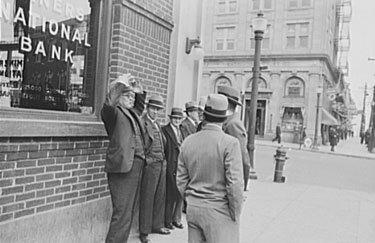
Shenandoah, Pennsylvania, corner of Main & Centre in front of Miners’ National Bank, circa 1940: coal miners on their days-off would customarily wear suits, neckties, and hats.
G. Bruce Boyer contemplates contemporary society’s abandonment of formality and dignity in favor of “casualness,” i.e. self-indulgent comfort and the absence of effort.
In the early years of the nineteenth century there had been what fashion hisÂtorians have called the “Great Masculine Renunciation†in Western male dress, as men turned their collective backs on all the silks and satins, buckled shoes and powdered wigs of court dress, and assumed the Victorian black worsted suit and cotton shirt of bourgeois middle-class business attire and propriety. The theory, first popularized in 1930 by the psychologist J. C. Flügel, attempted to account for the radical shift that men made to more sober attire after 1800, and the shift is usually seen as an expression of the triumph of the middle class, Âenlarging democracy, and the Industrial Revolution. A more ornate and chivalric ideal was replaced by the modest masculinity of a bourgeois gentleman in a democratic society. A gentleman’s clothes became more sober and standardized, his manners more reserved and proper. The very idea of a “gentleman†seems stuck in the nineteenth century.
At the end of the twentieth century, dress underwent another great change; call it the “Tailored Renunciation†or the “Casual Revolution.†Underlying it is not the triumph of one class but rather the loss among all classes of a sense of occasion. By “occasion†I mean an event out of the ordinary, a function other than our daily lives, an experience for which we take special care and preparation, at which we act and speak and comport ourselves Âdifferently—events which could be called ritualistic in matters of Âpropriety and appearance. There used to be many of these events, social rituals that filled our non-working lives: weddings and funerals, going to church, restaurants, parties, and theaters. Meeting important people of various stripes, people who had greater social standing than we did, was an occasion for our parents and grandparents to dress up, and that included going to the doctor’s office when you were sick, because the doctor was thought to be an important person worthy and deserving of that outward sign of respect. Respect for the event and those in attendance was what made the occasion special.
It can now be said that this sort of an outward sign or almost any of the older outward signs of ritual are considered pure snobbery. After all, wasn’t the Edwardian Age the last time the really rich could hope to think that showing off their wealth in public display gave the poor a nice bit of entertainment and ray of sunshine in their drab lives?
But then, if these outward signs are socially discouraged today, what makes an occasion special? And how do we know? Can an event be an occasion if there’s no attempt to outwardly manifest it? ÂRitualized behavior of one sort or another may be considered an outward sign of our inward disposition. But how complete can this be if it is not expressed in our appearance? We need not agree with Nicolás Gómez-Dávila’s claim that evening dress is the first step toward civilization to think that something has gone amiss. Is it possible to believe that when we now wear polo shirts, khakis, and hyper-designed athletic shoes to weddings, funerals, and graduations, it’s a sign that we have forgotten how to enjoy the events by which we measure life?
RTWT
Hat tip to Karen L. Myers.
09 Feb 2017


Palomo Spain men’s wear at 2017 New York Fashion Week. more examples here.
Vogue:
[A]s the first look walked out, a man to my right said out loud in pure exhilaration: “Gender! So last season!â€
What would result lived up to and, in fact, beyond the hype—and it was a privilege to witness. Not a moment too soon, and somehow fitting for the final day of the menswear loop, Palomo sent out a lavish and over-the-top collection that, at its core, gave a bejeweled and feather-trimmed middle finger to the unaccepting and the regressive. How fabulously timely.
———————————-
PaperMag:
The 24 year-old, who told Vogue in an interview last month that he works with “materials that are usually used for womenswear”, founded the label less than a year ago and has since been doing the most to shatter the traditional gender binary that has long ruled men’s fashion.
Alejandro’s Spring ’17 collection is so goddamn regal it hurts. Think Elizabethan ruffles meets Studio 54 with thigh-high boots (held up by garters no less!), pleated schoolgirl skirts and of course, a lot of skin.
Adios forever heteronormativity, one corset at a time.
———————————-
W Magazine:
[T]he Palomo Spain fall 2017 collection looked like what would happen if a young Spanish prince got into his mother, the queen’s, wardrobe. Or if a matador was feeling a bit kinky. (It also owed a major debt to the in-your-face hauteur of the the bad boys of the so-called Movida Madrileña of post-Franco Spain, like Pedro Almodovar.) The show opened with a feminine take on suiting, with ruffles, bell sleeves, and exposed shoulders. And closed with virginal boys in all white gowns and garters, plus one latex suit that resembled a bridegroom’s condom.
“It’s all the boys in the club,” said Palomo of his collection the following day. “You’ve got the dandies, the very serious, masculine guys, and then you’ve got the slutty boys in high boots.”
For his first two collections, Palomo had a much more romantic, poetic approach, but for this season he wanted to be less “beautiful” and more naughty. “It’s not this naive thing anymore,” he added of his relationship to fashion. “I wanted to go a little further to a more sexual place. It’s about trying to find your sexual self inside and exploring it. What’s the role of sex in our lives?”
Before he could answer, the tall and slender model named Pol Roig waltzed over wearing a bedazzled sequin houndstooth blazer, knee-high sliver go-go boots, and nothing else. He reached his hand into the pocket of Polomo’s pants and pulled out his iPhone. “See! This is what I’m talking about,†said Polomo, with a laugh. “We thought about putting trousers on him, but he looks better without.” And it’s true, he did. He just lacked pockets of his own.
“When you feel attracted to something, you can’t control your body,” said Polomo, who nervously stroked a rose flower while he spoke, eventually breaking its stem.
———————————-
It seems odd that at least one major industry is dominated by the mentally disordered and psychologically defective. That sexual perversity is able to strut openly as an identity is symptomatic of Liberal Egalitarianism’s inability to resist any grievance-bearing constituency.
This sort of thing went on, as well, in Ancient Rome, and, then as now, was recognized as gravely symptomatic of that Empire and Society’s imminent downfall.
Apart from celebrating our culture’s impending Apocalyptic collapse into supine decadence, I personally find it impossible to understand the point of all of this. How do you make money by producing a clothing line of grotesque statements of perversity that not even a West Village Queer could possibly wear anywhere outside a Gay Pride Parade?
Macy’s will not be purchasing this stuff for its Men’s Department. There must be some unfathomable-to-straight-guys connection between these kinds of costume statements and clothing for women that women actually buy. There is a profound mystery there.
02 Feb 2017


Decius identified as Michael Anton, the figure on the right
Claremont Institute last Fall made a major splash by publishing a revolutionary manifesto by a Trump-supporting intellectual, who struck learned, classical poses while championing Alt-Right demands for a new blend of Populism and Nationalism to replace the Conservative Movement and the politics of Goldwater, Buckley, and Reagan.
This provocative writer chose to be anonymous, appearing in the mode of 18th century polemicists under a Classical pen-name, in his case: Publius Decius Mus, a 4th century B.C. Roman consul who, according to Livy, facing imminent defeat, deliberately sacrificed himself in battle, having first offered up himself and the enemy to the gods of the Underworld and the Earth, thus gaining for Rome the victory.
Several further articles by Decius appeared during the course of the electoral campaign, and word leaked out in Conservative circles that Decius was none other than Tucker Carlson, who needed to be anonymous because he was right on the verge of a major new deal with Fox News. I, like a lot of people, believed those rumors, but we all politely kept our mouths shut, thinking that, despite our disagreements, the author was entitled to his privacy and his career opportunities.
It appears that it was just as well that nobody went public with the Tucker Carlson rumor, because here is Michael Warren, in the Weekly Standard, telling us that Mousey is a completely different guy, a fellow named Michael Anton.
On a late January afternoon, as press secretary Sean Spicer walked into the White House media briefing room, a tall, thin, bespectacled man poked his head in the doorway for a moment before turning around and heading back into the West Wing. Later that week, at another briefing, the man stayed longer, standing in the corner behind the podium, out of view of the array of television cameras.
The reporters peppering Spicer with questions were unlikely to know it, but the wallflower watching over the proceedings happened to be the leading conservative intellectual to argue for the election of Donald Trump. His pseudonymous essays during the campaign sparked more discussion—and disputation—among thinkers on the right than just about anyone else’s. Rush Limbaugh spent hours on his radio show promoting what he hailed as the writer’s “shaming” of the Never Trump conservatives. Leading conservative opponents of Trump, like New York Times columnist Ross Douthat, National Review’s Jonah Goldberg, and Washington Post columnist Michael Gerson, published critical responses to his most widely read essay. The writer even granted a postelection interview to the New Yorker, on the condition that his real identity not be revealed. The magazine described him as among those trying “to build a governing ideology” around Trump.
Now he’s helping to implement that governing ideology directly. The writer is a senior national-security official in the Trump White House, nearly a decade after serving in a similar role for George W. Bush. His unmasking ends one of the remaining mysteries of last year’s crazy and unpredictable election.
The enigmatic writer’s real name is Michael Anton, and he’s a fast-talking 47-year-old intellectual who, unlike most of his colleagues, can readily quote Roman histories and Renaissance thinkers. But readers knew him throughout 2016 as Publius Decius Mus, first at a now-defunct website called the Journal of American Greatness and later in the online pages of the Claremont Review of Books. As Decius, Anton insisted that electing Trump and implementing Trumpism was the best and only way to stave off American decline—making a cerebral case to make America great again.
——————————-
Looking up Michael Anton on the Internet proved tricky.
There appeared to be three of them: one Michael Anton wrote articles for Claremont Review under his real name; one Michael Anton (Michael Anton Mansour) attended Auburn, played football there, and then went to Hollywood where he became an actor, writer, and filmmaker; the third Michael Anton is a sort of contemporary Beau Brummel, a style-maker expert on masculine tailoring and haberdashery, who has written a book, The Suit: A Machiavellian Approach to Men’s Style under the pen-name Nicholas Antongiavanni.
Michael Anton Number 3 is all over the place on the Internet, pontificating pompously on male clothing. Photos of him, I believe, are up there misidentified as being of the actor-writer-filmmaker Michael Anton Number 2.
My own guess is that Michael Anton Number 1, Alt-Right Trump supporter and Claremont Review’s Decius, is the same as Michael Anton Number 3, the clothes horse. Compare the photo below to the one above.

Mens’ Tailoring Expert Michael Anton
06 Dec 2016


While he was still running for president in October of 1860, Abraham Lincoln received a letter from eleven-year-old Grace Bedell advising him to improve his appearance by growing a beard. Lincoln took the little girl’s advice and won the presidency.
It seems a pity that Grace Bedell wasn’t around this year to tell Donald Trump to get rid of the groundhog, quit dyeing his remaining hair yellow, and stop using the tanning makeup. But Gerard Van der Leun stepped up in her absence, and has offered a Photoshop makeover of The Donald, demonstrating that he could look pretty respectable.
Trump should hire Gerard to supervise his personal grooming.
—————————————————
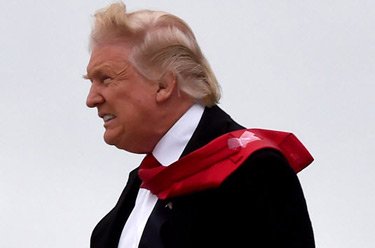
It would also help the President-Elect look better and more presidential to get better suits from a better tailor, to wear grey flannel, pin-stripe, and occasionally glen plaid and not only always the same Navy Blue.
Someone needs to explain to Mr. Trump that a gentleman looks best wearing his suit coat buttoned (one button only) when standing up.
An older, gravitationally-challenged fellow might also look better wearing a vested suit.
Mr. Trump really needs a letter from Grace Bedell pointing out to him that he ties his neckties too long. One’s necktie ought to end in the middle of one’s beltline. Mr. Trump’s ties are invariably tied with the front dangling down far too long. The above photo demonstrates that Trump ties his neckties so long in front that the rear portion of the tie is too short to be reliably contained by the loop. Poor Donald has reduced himself to having to scotchtape his tie together in back. Jesus wept!
Scotchtaped Tie Revealed!
03 Dec 2016

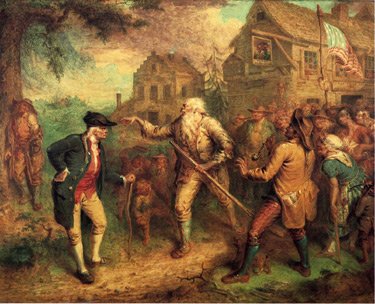
John Quidor, The Return of Rip van Winkle, 1849, National Gallery of Art, Washington, D.C.
Boards.IE:
If you occupied what was considered the ideological / moral centre ground in 1966, and went to sleep for 50 years and woke up in 2016 you’d find yourself occupying the ideological /moral ‘far right’. You didn’t have to budge one inch ideologically to find yourself there. The whizzing sound you heard was the ideological / cultural centre ground zooming over to the Cultural Marxist hard left.
Everything that was considered mainstream, obvious, common sense, logical and moral in 1966 is now considered by our political, academic and media elite to be bigoted, ignorant, hateful, xenophobic, racist, extremist and some form of moral abnormality.
In other words, within the space of 50 years, morality, right, wrong, evil, good, normal, obvious, extreme, sanity, truth, beneficial, dangerous and the instinct for group preservation, has been inverted and stood upside down on its head.
Never before in the entire course of human history has an entire culture, race and civilisation decided to hand over its lands, social capital, heritage and identities to competing and intruding alien cultures without a fight, and even worse, to evolve an ideology that morally justifies and glorifies it as proof of their moral supremacy.
European man is in a civilisational death dance.
Hat tip to Vanderleun.
14 Jul 2016


News of Theresa May’s accession to Prime Minister was eclipsed yesterday in some quarters by gushings over her husband Philip’s well-tailored, single-button blue suit.
Metro.Uk and Twitter went wild:
Theresa May became Britain’s new prime minister, but her husband’s big fashion moment stole the show.
Stepping into the limelight as First Man, Philip May showcased a sexy navy suit with a flourish of pinstripe.
Britain’s new Prime Minister Theresa May speaks outside 10 Downing Street in central London on July 13, 2016 on the day she takes office following the formal resignation of David Cameron. Theresa May took office as Britain’s second female prime minister on July 13 charged with guiding the UK out of the European Union after a deeply devisive referendum campaign ended with Britain voting to leave and David Cameron resigning. / AFP PHOTO / OLI SCARFFOLI SCARFF/AFP/Getty Images
Theresa May’s speech in full as she becomes Prime Minister
A single fastened button at the waist helped show off his fantastic figure and a pale blue tie brought out the colour of his eyes.
Round glasses perched on his nose accentuated his amazing bone structure – no doubt one of the assets he used to help him to bag his wife.
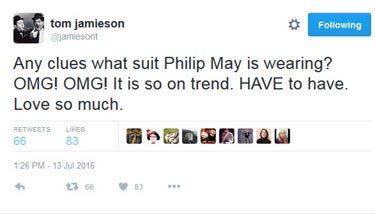
—————————————–
Mr. May’s haberdashery has evidently been attracting complimentary attention in the media for some time. Marie Claire actually devoted a feature to his suits and ties, noting approvingly that he frequently coordinates his outfits with hers.
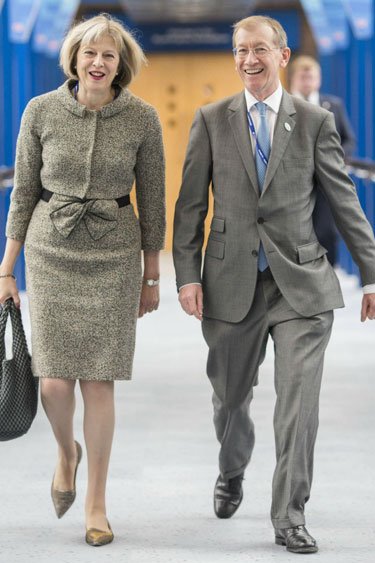
Jasmin Nahar, at Buzz Feed UK, is envious of the PM:
A man who can dress himself and has a job? Where do I sign up?
16 Apr 2016


Harry Mount is frustrated to find that most tailors have succumbed to the two-button suit trend.
Last week I walked along Jermyn Street, spiritual home of the gentleman’s suit, and noticed something shocking. The jackets in the shop windows had lots of materials — tweed, cotton, wool — in all colours, shades and checks. But every single jacket had two buttons.
When did tailors get so boringly uniform? Why has the three-button suit — the classic style that dominated the 20th century — been wiped off the map? As a diehard three-button man, am I a fogeyish dinosaur, a walking Bateman cartoon: ‘The Man Who Wore a Three-Button Suit in the 21st Century’?
I seek solace (and a new three-button suit, in storm- grey, 13-ounce birdseye wool) from Tina Loder, a tailor for more than 30 years, and one of the few women tailors on Savile Row. ‘We’re going through a two-button cycle, just as we went through a three-button cycle a decade ago,’ she says. ‘Two buttons signal a casual informality and egalitarianism.’
But what if I don’t want to look casually informal and egalitarian?
Read the whole thing and insist on three-button suits.
Hat tip to David Wagner.
/div>

Feeds
|
